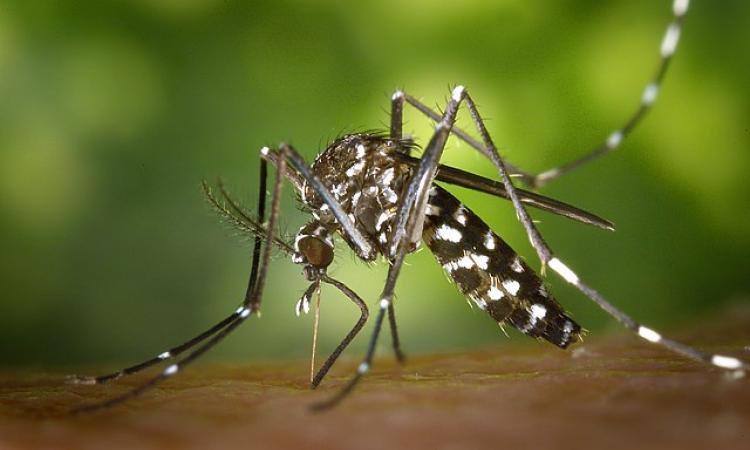
Dengue is witnessing an alarming rise in India in recent years and the National Vector Borne Disease Control Programme (2020) data shows a five fold increase in cases of dengue from 28,066 cases in 2010 to 157,315 cases in 2019.
Dengue and climate change
The paper titled 'Distribution expansion of dengue vectors and climate change in India' published in the journal GeoHealth informs that dengue is a viral infection that is transmitted through the bite of mosquitoes (vectors) namely, Aedes aegypti or and Aedes albopictus. Aedes aegypti is normally found indoors and mainly feeds on human blood during the day. It is mostly found in urban areas and usually breeds in accumulations of water such as plastic containers and rubber tyres. Aedes albopictus prefers to rest outdoors and is an opportunistic feeder.
A number of climatic factors such as temperature, rainfall and relative humidity affect the presence of mosquitoes or dengue vectors. For example, mosquitoes are extremely sensitive to changes in temperature, which affects their larval development as well as vector mortality and rainfall also aids in replication of vector populations by providing suitable habitats for development of the aquatic larval stages.
Climate change is giving rise to erratic and extreme rainfall patterns, rise in temperature and humidity creating favourable environmental conditions for the breeding of dengue vectors.
The drastic rise in dengue cases in India calls for the need to make more concerted efforts at dengue management and vector control. While no known vaccine or specific treatment for dengue exists, dengue control in India is mainly based on vector control practices such as indoor space spraying, fogging, environmental management and promotion of personal protection.
Lack of data on dengue distribution
However, the nation-wide distribution of dengue vectors in India is not known and the presence of aedine species has been established only in some parts of the country such as in southern peninsular India, North eastern states as well as the western and eastern coastlines. It has also been found that climate change could significantly affect the known distribution of vectors.
Species distribution modeling (SDM) has emerged as an important tool for identifying the ecological niche and climate change induced shifts in different species. Maximum Entropy (MaxEnt v3.3.3) is a machine learning algorithm used for modeling species distributions using presence-only records. Its predictive performance is highly competitive as compared to other SDMs and has been used extensively since becoming available in 2004.
This study uses the MaxEnt model for predicting the present and future distributions of Aedine vectors of dengue in India under three different climate change scenarios namely – low emissions scenario (RCP 2.6), moderate emissions scenario (RCP 4.6) and high emissions scenario (RCP 8.5).
Findings
- The study finds that the distribution of dengue vectors is widespread in India and climate change will significantly increase the risk of expansion in some parts of Thar Desert and upper Himalayas.
- The risk is also high in north east India as well as the western coastline, where both Aedes aegypti and Aedes albopictus have high prevalence, although the reported cases of dengue do not reflect this.
- Aedes aegypti is more common in the Deccan plateau and the semiarid regions of Gujarat and Rajasthan, while Aedes albopictus in the eastern coastline.
- Aedes aegypti is projected to witness more widespread increase in distribution under low emissions scenario (RCP 2.6) in 2030 and 2050s, whereas marginal reduction is observed in most parts of the country under moderate and high emissions scenario (RCP 4.5 and 8.5).
- There will be a significant increase in conditions that will be suitable for proliference of Aedes aegypti in the eastern parts of the country by 2070 under the high emission scenarios (RCP 8.5).
- The suitability for Aedes albopictus remains largely similar in most parts of the country by 2030s. Increase in the abundance of Aedes albopictus is projected in southern India, upper Himalayan regions of Leh (Ladakh) and Arunachal Pradesh by 2050s and 2070s under high emission scenarios (RCP 8.5).
- The states which regularly report high incidence of dengue, namely Gujarat, Maharashtra, Punjab and Karnataka (NVBDCP, 2020) are also predicted to have very high distribution of Aedes aegypti and/or Aedes albopictus.
- The model outputs show disagreement with dengue incidence in the states of Rajasthan and north-eastern parts (NVBDCP, 2020). In Rajasthan, the distribution of both the vectors is low but the incidence of dengue is high. The water storage practices in dry parts of Rajasthan are perhaps not being captured by the climatic variables suitable for Aedes. In North eastern states, it is just the opposite, which can be explained by oversampling efforts (NVBDCP, 2020). Further studies are warranted to ascertain the reasons for low incidence in north eastern states as well as the future risk of dengue in view of climate change.
- Temperature related factors are found to be significantly associated with availability of suitable environment for proliferation of Aedes aegypti, whereas precipitation related factors contribute more significantly to presence of suitable environment for proliferation of Aedes albopictus.
The findings of the study identify areas with projected expansion of Aedes aegypti and Aedes albopictus and call for strengthened efforts for entomological as well as dengue surveillance. The projected maps can be greatly useful in guiding the ground surveillance efforts in projected areas of distribution of both the vectors, informs the paper.